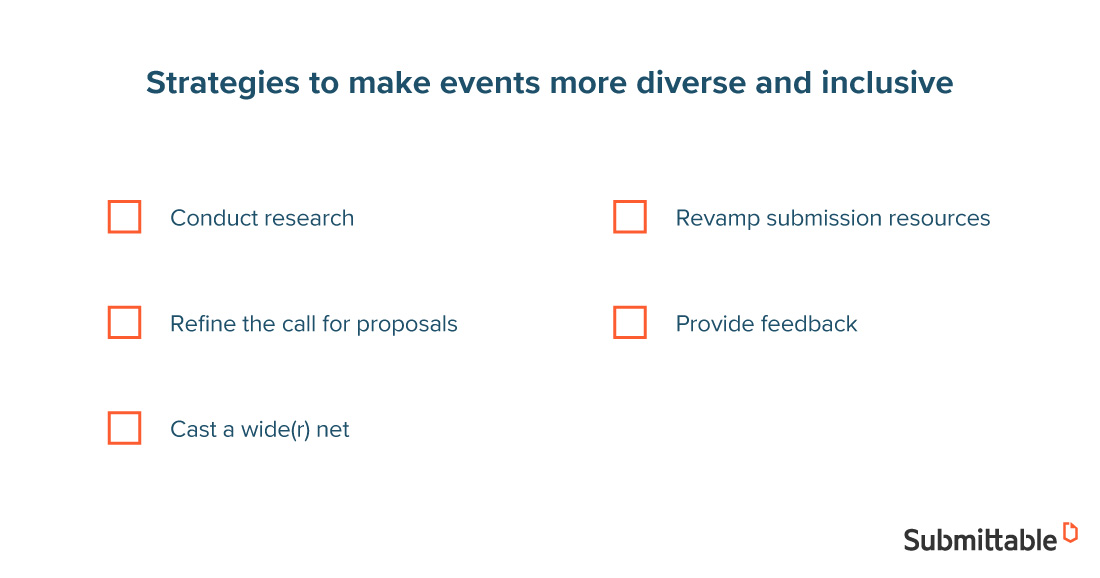A smattering of Black and Brown faces in (mostly) white spaces.
An all-male panel that completely lacks perspective.
A three-day conference without any queer voices.
In 2020, conference organizers must do better than this very wanting status quo.
To accomplish that, those running conferences must move beyond diversity as a buzzword. It’s no longer an abstract concept. Diversity is a way of thinking that’s not only more fair, but also better for everyone.
When your audience sees themselves reflected in your speaker lineup, they’re more connected to the programming. With a diverse array of presenters, you’re offering a more well-rounded and engaging view of virtually any topic.
You’re also building a fairer and more just world, one conference panel discussion at a time.
The first step is to understand the multiple dimensions of diversity. One major facet of diversity involves the degree to which those on stage resemble broader audiences.
For example, many conferences seriously lack when it comes to gender diversity. Just ask Jeremy Goldman, founder of the Firebrand Group (now Proponent), an award-winning digital marketing and creative firm based in New York City:
“The male to female ratio on stage doesn’t represent most audiences,” notes Goldman. Far too many conference stages are overwhelmingly male while the audiences are much more balanced.
So what’s a conference organizer to do?
From technological resources to research-backed strategies, there are many ways to ensure diverse and equitable conference spaces. Let’s dive into promising approaches for making it happen.
How to ensure equity in the speaker lineup at your next conference

If you build it, they (i.e. a diverse array of conference speakers) will come.
Securing a diverse conference speaker lineup requires lots of intentional work months before the event takes place. The key parts of the process begin several steps before you even engage with prospective conference speakers.
From exploring the professional landscapes from which you’re drawing speakers to giving feedback to applicants and speakers at the end of the whole process, let’s step through an ideal strategy to ensuring a diverse lineup.
Conduct research
It starts with knowing the industries and markets shaping the focus of the conference. For example, while organizing a panel discussion on the topic of social media management, it would help to know that 70-80% of social media managers identify as women.
Why?
Perhaps you want that panel to reflect the realities in the industry. Having that data handy helps you understand the market and hone the speaker list.
Another way to beef up conference speaker diversity through research is to dig into your own data. Administer and review evaluation surveys at the end of every conference. Ask targeted questions about the speakers that attendees want to hear from and use it to inform your speaker recruitment strategy.
Understand what keeps some attendees coming back each year and what prevents others from attending in subsequent years. Leverage internal and external data to better understand your audience and inform your approach to speaker recruitment.
Refine the call for proposals
How you solicit speakers can make a huge difference.
Don’t just trust the process. Optimize it for diversity.
Make sure to announce the call for proposals as early as possible to maximize access and planning time for underrepresented groups. Strive for gender-neutral language throughout the call for proposals itself.
When it comes to proposal review, make sure entries are anonymized (a good submission management platform will do this for you) and remove any gendered pronouns. Anonymous review is a tried and true practice in the academic publishing community for good reason.
Ensure that your reviewers are as diverse as the attendees and speakers you’re looking to fill your conference. This won’t always be a one-to-one match of course but it’s a critical first step to providing for a diversity of identities and perspectives.
Within the actual review process itself, applications should be anonymized to ensure equity while reviewers should be allowed to look at key parts of the submission rather than being overwhelmed by too much information.
Cast a wide(r) net
Your outreach at this stage can be a gamechanger.
When conference organizers default to passive recruitment methods, we end up with conferences lacking in diversity. Ensuring diversity by design is the goal here.
Get out there and look for experts, rather than just individuals on the speaking circuit. Be careful navigating titles as it’s easy to simply choose based on titles which just reinforces the status quo. Lean into proven networks that exist, in part, to help diversify conference speaker lineups while providing more opportunities to underrepresented experts and professionals.
Be transparent about your desire for a diverse conference by making it a key part of your application process for potential speakers. Get recommendations for speakers from a diverse array of recommenders so that the potential speaker pool is just as broad.
Remember, it’s not only okay to set goals (often called “quotas”) for diversity and hold yourself accountable to those goals. Companies set revenue and profit goals all the time. Why shouldn’t diversity goals be folded into the mix as well?
For example, many conferences and even music festivals are setting goals for gender parity on the front-end and sticking to them through their talent recruitment processes. In doing so, they’re likely attracting an improved array of speakers and attendees while enhancing the overall quality of experience for attendees.
Here’s a big one: Don’t just ask people of color to speak about diversity. That’s a classic pigeon-hole tactic that increasingly turns people off from certain conferences.
Revamp submission resources
It’s time to bring those speaker recruitment materials into the modern era.
Your submission platform should reduce barriers to entry and allow you to pull in more (and more diverse) applications. It should be streamlined and easy-to-navigate for applicants as well as your conference planning team.
By increasing the efficiency of your submission software, you free up your conference organizers to focus outreach efforts on building a more varied speaker roster.
A modern submission platform can help you offer helpful resources to accompany your call for proposals to support potential speakers in their application processes. These resources can range from links to past talks and information about how proposals are processed to response dates and resources provided to accepted speakers.
Make sure that potential speakers have the relevant information they need about what it’ll take to speak at the conference and have clear instructions for submitting a winning application. Upgrading your submission software gives broader and more transparent access to important information applicants will need to successfully speak at your conference.
In short, beefing up your submission portal and providing targeted resources to applicants helps organizers proactively draw a more diverse group of speakers to future conferences.
Provide Feedback
Without honest feedback and mentorship, it’s hard to grow.
That same principle applies to potential conference speakers. Many underrepresented applicants just don’t get that kind of support which fuels the cycle of un-diverse panels and discussions at conferences.
When applicants aren’t a great fit for a specific conference, take the time to give them feedback on their application to help them improve. Chances are, next year they’ll reapply and make the conference you’re organizing even better.
Also, don’t hesitate to recommend them to other conference organizers if you think they’re a good fit. Consider offering free or low-cost training to certain groups of applicants as well. Give low-stakes speaking opportunities such as lightning talks or micro-sessions to underrepresented applicants.
Even more tangibly, offer financial support to potential speakers. Between the time off, flights, hotels, rental cars, meals, etc. — it’s expensive to attend conferences! Ease the burden for speakers and watch your pool of applicants grow more diverse in doing so.
Relatedly, go big and launch a diversity fellowship program that specifically reaches out to a diverse pool of potential speakers and brings them into the fold.
These are all proven methods for creating a more diverse speaker pool for your conference and the conference circuit more broadly.
Streamline your call for papers review process with a modern submission platform
A major part of conference diversity involves improving the review process for conference proposals.
Conference organizers can now leverage modern submission software to get that key job done.
Such technology can help conference organizers achieve a few key goals:
- Automation of application review and scheduling
- Data collection and synthesis
- Reduction of front-end friction in the application process
- Integration of back-end systems
Whether you’re automatically assigning reviewers to submissions based on specific areas of expertise (or other rules) or sending an email blast to reviewers and notifications to prospective presenters, automation can save time and help organizers focus on more important aspects of the conference planning process, including finding a diverse lineup that will benefit everyone.
Embracing the strategies and tactics outlined above and investing in a powerful submission platform can help conference organizers refine their speaker recruitment process while ensuring a more diverse array of speakers at their next event.
Don’t blindly trust the current speaker recruitment process. Build a better one. And don’t believe that more diverse speakers aren’t out there—they are. You just may not have the strategies in place to find them yet.
